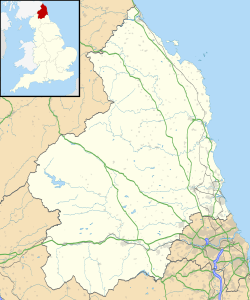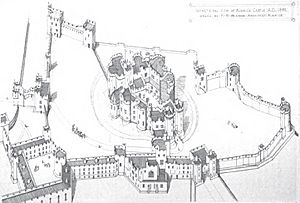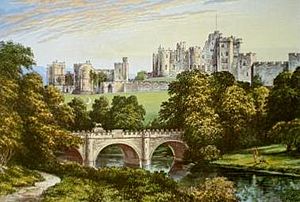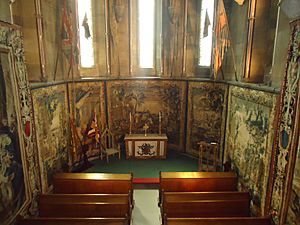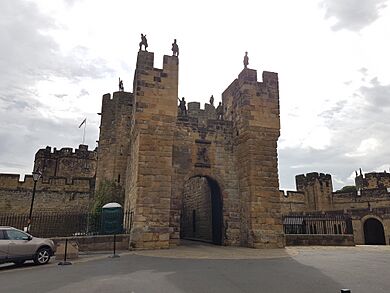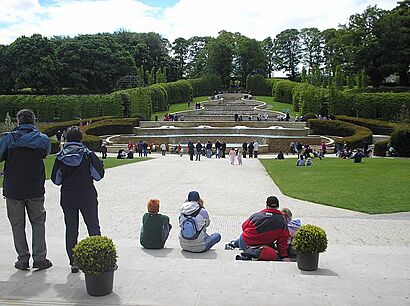Alnwick Castle facts for kids
Quick facts for kids Alnwick Castle |
|
|---|---|
| Alnwick, Northumberland | |
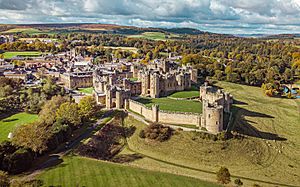
Alnwick Castle
|
|
| Coordinates | 55°24′57″N 1°42′22″W / 55.4158°N 1.7062°W |
| Site information | |
| Owner | The 12th Duke of Northumberland |
| Site history | |
| Built | 11th century |
|
Listed Building – Grade I
|
|
| Official name: Alnwick Castle The Castle, Stable Court and Covered Riding School including West Wall of Riding School | |
| Designated | 20 February 1952 |
| Reference no. | 1371308 |
| Official name: Alnwick Castle | |
| Type | Grade I |
| Designated | 1 January 1985 |
| Reference no. | 1001041 |
Alnwick Castle (pronounced AN-ik) is a famous castle and home in Alnwick, a town in the English county of Northumberland. It is the home of the 12th Duke of Northumberland and his family.
The castle was first built after the Norman Conquest of England in 1066. It has been repaired and changed many times over the centuries. Today, it is a Grade I listed building, which means it is a very important historic site. Along with the nearby Alnwick Garden, the castle is a popular attraction, welcoming many visitors each year.
Contents
The Castle's Long History
Alnwick Castle was built to guard a road that crossed the River Aln. The first parts of the castle were built around 1096 by a Norman nobleman named Ivo de Vesci.
The castle was first written about in 1136 when it was captured by King David I of Scotland. At the time, it was described as being "very strong." It was attacked again in 1172 and 1174 by William the Lion, the King of Scotland.
The Powerful Percy Family
The castle eventually came into the hands of the Percy family. The Percys were a very powerful family in the north of England. When Henry Percy bought the castle, it was a simple stone building. He immediately began to rebuild it, turning it into a major fortress on the border between England and Scotland.
His son, also named Henry, continued the building work. Some parts from this time, like the Abbot's Tower and the Middle Gateway, still stand today. The Percys made the castle a strong military base but also a comfortable home.
The Wars of the Roses
During the Wars of the Roses, a series of civil wars in England, Alnwick was an important site. It was one of three castles held by the Lancastrian side in 1461 and 1462. The castle was captured and recaptured several times by both the Lancastrians and their rivals, the Yorkists.
After many battles and sieges, the castle was finally secured by the Yorkists in 1464. Later, it was returned to the Percy family after they showed their loyalty to the king.
Later Changes and Styles

For over 100 years, the Percy family did not live at Alnwick. The castle was even used to hold prisoners in 1650 by Oliver Cromwell.
In the 1700s, the Percy family returned. They hired famous architects like Robert Adam to make big changes. The inside of the castle was decorated in a Gothic style, which was very fashionable at the time.
Then, in the 1800s, another Duke of Northumberland, Algernon Percy, decided to change the castle again. He wanted it to look more like a real medieval castle. He hired the architect Anthony Salvin, who is responsible for much of how the castle looks today, including the grand Prudhoe Tower.
Alnwick Castle Today
The current Duke and his family still live in the castle, but they only use a part of it. The rest of the castle is open for the public to visit during the summer. After Windsor Castle, it is the second-largest castle in England that people still live in.
Over the years, the castle has also been used for education. During World War II, a girls' school was moved here for safety. Later, it was a college for training teachers. Today, it is used by St. Cloud State University from the United States as a place for students to study abroad.
Three of the castle's towers have special exhibits. You can see ancient art from Pompeii, objects from Ancient Egypt, and displays about local military history.
The Castle's Design

The castle is made of two main rings of buildings. The most important rooms are in the central part, called a shell keep. This area is protected by ten towers packed closely together.
A large wall with ten more towers surrounds this central part. Some towers are D-shaped to be stronger against attacks, while others are rectangular to provide more living space. One interesting feature of the castle is the carved figures on top of the walls. Some of these statues are from around 1300, while others were added in the 18th century.
The Alnwick Garden
Next to the castle is the Alnwick Garden. This beautiful garden was created by Jane Percy, Duchess of Northumberland. It features a large, cascading fountain at its center. The garden is a separate charity, but the Duke donated the land and money to help create it.
The garden also has a huge "treehouse" complex with a café, which is one of the largest in the world. In 2005, a "poison garden" was added. It grows dangerous and poisonous plants to teach visitors about them in a safe way.
Alnwick in Movies and TV
Alnwick Castle is a popular choice for filming movies and television shows because of its amazing appearance.
What movies were filmed at Alnwick Castle?
Some of the famous movies filmed here include:
- Robin Hood: Prince of Thieves (1991)
- Elizabeth (1998)
- Harry Potter and the Philosopher's Stone (2001)
- Harry Potter and the Chamber of Secrets (2002)
- Transformers: The Last Knight (2017)
- Dungeons & Dragons: Honour Among Thieves (2023)
For the Harry Potter films, the castle was used for many of the outdoor scenes of Hogwarts. This has made the castle very famous with fans all over the world.
What TV shows were filmed at Alnwick Castle?
Television shows filmed at the castle include:
- The Black Adder (1983)
- Robin of Sherwood (1984-86)
- Downton Abbey (2015-16)
See also
 In Spanish: Castillo de Alnwick para niños
In Spanish: Castillo de Alnwick para niños


